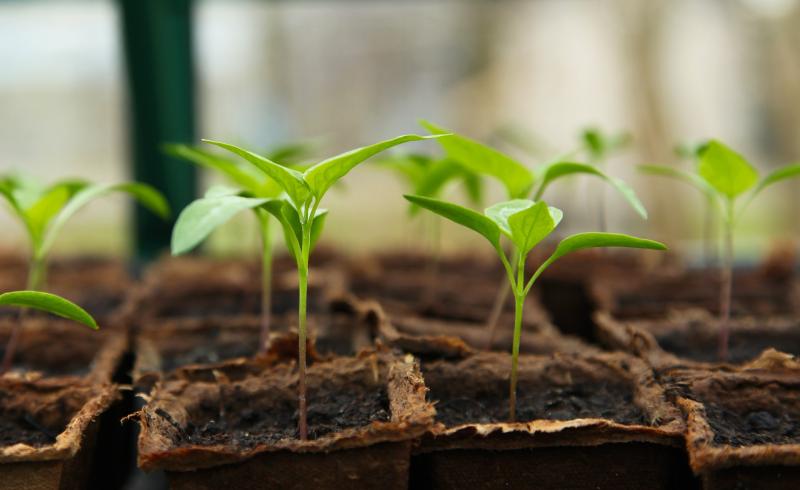
Each winter, many gardeners eagerly look forward to getting back out into the vegetable garden. Most gardeners realize that the average last spring frost date in eastern Nebraska is May 10th. Meaning until that date, some vegetable transplants or new seedlings planted outside may need extra protection in the event of a frost.
One way to provide plant protection is through the use of hotcaps, a container or structure placed over the plant. Ideally hotcaps allow enough sun to reach the plant for good photosynthesis to occur and to warm the air inside the structure around the plant, but not so much that plants are damaged by overheating. Hotcaps should also retain sufficient heat during the night to protect plants from low-temperature injury. Finally, they protect the plant from early spring wind and the damage it can cause young transplants.
Common hotcaps used by many gardeners to protect plants include Wall-O-Water, waxed paper cones or homemade protection devices like milk jugs. Research conducted by researchers at Virginia Polytechnic Institute evaluated how these three common hotcap designs affected the growth and development of tomato transplants. Microclimate sensors were used to monitor air temperature, relative humidity, and light quantity and quality inside and outside the hotcaps. Tomato transplants were evaluated for vigor, color, height and yield.
- Milk jugs are readily available and inexpensive. Jugs were attached with wire to bamboo stakes adjacent to the plants.
- Waxed paper cones commonly are available through garden supply stores and would be considered a "standard" method for protection from spring frosts. They are easy to install and disposable. Each paper cap's edges are secured by burying in soil.
- Wall-O-Water, or water-filled plastic tubes collect solar heat during the day and then release it at night. The tubes are filled with 2.5% water/bleach solution to reduce algal growth. Plastic tubes can be tricky to fill and although they are reusable, they require cleaning between seasons. They are also more expensive than the other two types of hotcaps. Current pricing is approximately $14.99 each compared to .99 cents for waxed paper hotcaps.
Study Findings
All hotcap designs transmitted less than 70% sunlight, although plastic tubes transmitted less than either of the other designs. Under cloudy conditions, no design provided warmer soil temperatures than that for unprotected plants. On cloudy days, internal air temperatures were only three to six degrees warmer.
Plastic milk jugs could not maintain interior temperatures above the outside night temperature, so did not provide effective temperature protection. However, they did hasten ripening of the first fruit by 5 days, compared to unprotected plants, and did protect plants from wind damage.
Waxed paper hotcaps provided the highest average increase in daytime air temperature, over 21 degrees, but they did not retain heat at night. They averaged only one degree warmer than the outdoor night air. They did provide protection from wind damage and plants protected by paper hotcaps produced their first ripe fruit 6 days earlier than unprotected plants.
Wall-O-Water maintained the highest internal air and soil temperatures around the plants, moderating daytime and night-time temperatures better than either of the other protection methods. Highest night air temperatures in the plastic tubes were 3.4 degrees above the outside air. And they sped up ripening of the first fruit by 10 days.
So the best option for home gardeners to protect young transplants from spring frost is a water-filled plastic tube hotcap.
Using Wall-O-Water Effectively
Ventilating the plastic tubes is necessary on warm days. Spread the top open to increase ventilation, reduce humidity, and increase the amount of light reaching the plant. Reduced light penetration and high humidity in the plastic tubes can cause tall, spindly growth.
But Keep in Mind...
At the end of the study when the hotcaps were removed and danger of frost had passed, the plants grown in the hotcaps were tall, succulent, spindly and had poor color. The control plants, those not covered by hotcaps, were shorter at flowering, set more fruit on the first cluster and were darker green than those grown under hotcaps.
The nearly constant high humidity and low light levels under the various hotcaps contributed to the poor plant development. When the first flower cluster develops inside the hotcap, the lack of air movement and excessively high temperatures (greater than 85°F) may result in poor pollination.
So are you better off starting plants early and getting a tomato 10 days earlier than your gardening friends? Or waiting until plants can be left unprotected in the garden, resulting in healthier plants (shorter and darker green) plus more fruits on the first cluster? It's your call.